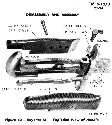

Springfield Armory Museum - Collection Record
Send us your own comments about this object.
| Title: | BAYONET, KNIFE - U.S. BAYONET MODEL 1905 SN# 84076 |
| Maker/Manufacturer: | SPRINGFIELD ARMORY |
| Date of Manufacture: | 1906 |
| Eminent Figure: | |
| Catalog Number: | SPAR 7410 |
| Measurements: | OL: 52CM 20 1/2" BL: 39.6CM 15 5/8" |
Object Description:
U.S. BAYONET MODEL 1905 SN# 84076
Manufactured by Springfield Armory, Springfield, Ma. in 1906 - Standard Model 1905 knife bayonet for M1903 rifle. Blade bright. Overall length of 20 1/2" and a blade length of 16". Classified as "standard" from 1905 until February, 1943 when changed to "limited standard." Declared obsolete in July, 1945.
Markings:
Blade: SA/Ordnance bomb/1906. US/84076.
Notes: O.O. Letter No. 26791-0-668 - 03/01/1905 - "KNIFE BAYONET FOR MODEL OF 1903 RIFLE: The adoption of a knife bayonet, with a blade 10 inches long, has been decided upon. This bayonet is of the same design as that for the Model of 1898 Rifle, except that the blade has been lengthened 6 inches. The blade is to be tempered and the cutting edges ground sharp.
The scabbard for this bayonet is to be made of a light material, and so made as to prevent rattling of the bayonet in the scabbard; and also to prevent the sharp edges of the bayonet from coming into contact with any metal of the scabbard."
"Having decided that a good bayonet was needed in view of the development in Manchuria of the night attack to reduce the value of firepower, the board selected a knife bayonet to replace the rod type, and issue of M1903 rifles to the Army was delayed while the rifles on hand for issue were modified to provide for the attachment of this bayonet.
Designated Bayonet, M1905, it was similar to the old Krag bayonet except that its blade was made 16", instead of 11 3/4", to partially compensate for the loss 'reach' due to 6" shorter barrel of the M1903 rifle. The M1905 bayonet differed, also, in using the Norwegian Krag system for locking, rather than the Mauser type of locking.
The method of attachment was to have the front end of the barrel project through the 'barrel hole' of the guard, with the bayonet lug on the upper band of the rifle fitting into the 'undercut groove' in the bayonet pommel and secured by the pivoted 'catch' inside the 'tang.' The 'scabbard catch', which actuated the 'catch', served also to secure to one of the 'mouthpiece hooks' of the scabbard. (The orginial catch was found, in Philippine service, to be defective in design, and all bayonets were reworked in FY 1908 to accept the new 'beefed up' replacement each of adequate strength.)
The blade was stamped near the guard on the left side with the Ordnance flaming bomb, the initials of the place of manufacture, and the year of manufacture. On the right side it was stamped with the U.S. and a serial number.
The finish, until U.S. entry into World War I, was 'browning' of all metal, except that the blades were polished 'bright.' Subsequent to U.S. entry into World War I, blades were 'browned', also. With the introduction of the Parker process after 1917, the finish was, of course, changed to Parkerizing.
The grips were of walnut (without the carving machine marks smoothed off) on the roughly one and a half million bayonets produced by the Government facilities at Rock Island Arsenal through 1919, and at Springfield Armory through 1922.
World War II production was begun in April, 1942 on contract by such companies as Union Fork and Hoe Co., Utica Cutlery, and Onieda, Ltd. The resulting bayonets differed from Government-made bayonets in being unnumbered and in having ribbed plastic grips, either black or brown.
Production of the 1905 bayonet ended May 1943, after 1,540,578 bayonets had been produced commercially, because of the standardization of a new, shorter bayonet, the M1." - Campbell
See Campbell, pg. 143.
References:
Brophy, William S. THE SPRINGFIELD 1903 RIFLES. Stackpole Books. Harrisburg, Pa. 1985.
Campbell, Clark S. THE '03 ERA: WHEN SMOKELESS REVOLUTIONIZED U.S. RIFLERY. Collector Grade Publications Inc. Cobourg, Ontario Canada. 1994.
Canfield, Bruce. U.S. INFANTRY WEAPONS OF WORLD WAR II. Andrew Mowbray Publishers Inc. Lincoln, R.I. 1998.
Hardin, A.N. THE AMERICAN BAYONET. Riling and Lentz, Philadelphia, Pa. 1964.